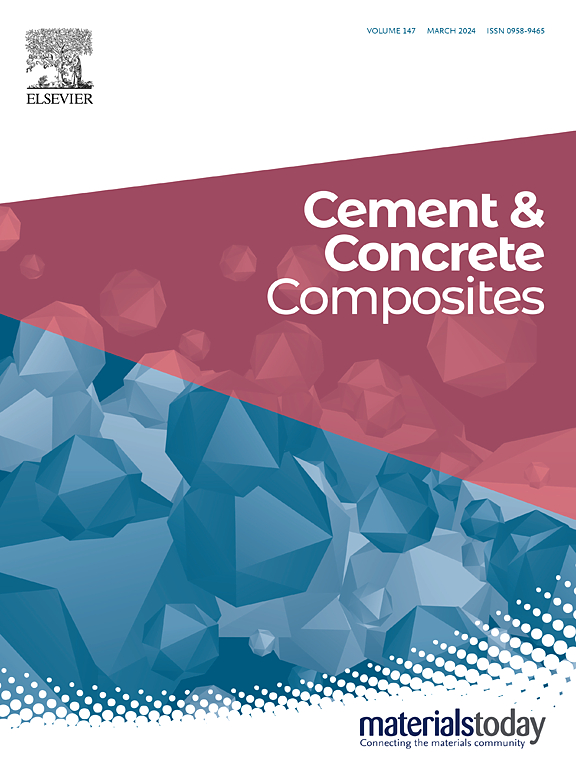Self-healing mechanisms in concrete cured in CO2-saturated environments: Synergistic effects of biomass forest ash and metakaolin
IF 13.1
1区 工程技术
Q1 CONSTRUCTION & BUILDING TECHNOLOGY
引用次数: 0
Abstract
This study investigates the effect of autogenous self-healing in high-performance ternary concrete mixes incorporating biomass forest ash when exposed to concentration of carbon dioxide (CO2). To analyse this phenomenon, three cementitious systems were studied: i) 100 % Portland cement, ii) 60 % Portland cement, 25 % biomass ash, and 15 % metakaolin, and iii) 60 % Portland cement, 25 % limestone filler, and 15 % metakaolin. The samples, prepared with different initial crack widths, were subjected to four self-healing conditions: i) continuous immersion in tap water (TW), ii) wet-dry cycles in TW, iii) continuous immersion in carbonated water (CW), and iv) wet-dry cycles in CW, over two exposure periods (28 and 90 days). The effectiveness of the process was evaluated through the analysis of surface crack sealing using a digital microscope and the recovery of impermeability through water permeability tests. To understand the chemical mechanisms involved, the self-healing products formed were analysed using SEM. The results showed that the samples self-healed in CW tended to exhibit lower surface sealing efficiency compared to TW, regardless of the mix type, due to the slightly acidic pH caused by the dissolution of CO2 into carbonic acid. However, in the higher pH inside the cracks promoted the precipitation of calcium carbonates, improving internal impermeability even without achieving effective surface sealing. In this context, biomass ash was particularly effective as a water reservoir, promoting more efficient internal curing when combined with metakaolin and achieving better results in terms of internal impermeability than conventional mixes with cement or limestone filler combined with metakaolin.
饱和co2环境下混凝土的自愈机制:生物质森林灰和偏高岭土的协同效应
本研究探讨了含生物质森林灰的高性能三元混凝土混合料在暴露于高浓度二氧化碳(CO2)时的自愈效果。为了分析这一现象,研究了三种胶凝体系:i) 100%波特兰水泥,ii) 60%波特兰水泥,25%生物质灰和15%偏高岭土,iii) 60%波特兰水泥,25%石灰石填料和15%偏高岭土。在28天和90天的两个暴露周期内,制备了不同初始裂缝宽度的样品,进行了四种自愈条件:1)连续浸泡自来水(TW), 2)干湿循环浸泡自来水(TW), 3)连续浸泡碳酸水(CW), 4)干湿循环浸泡碳酸水(CW)。通过数码显微镜对表面裂缝密封的分析和透水试验对不透水性的恢复,评价了该工艺的有效性。为了了解所涉及的化学机制,利用扫描电镜对形成的自愈产物进行了分析。结果表明,无论混合类型如何,由于CO2溶解到碳酸中造成的微酸性pH, CW中自愈的样品表面密封效率都比TW低。然而,在较高的pH下,裂缝内部促进了碳酸钙的沉淀,即使没有达到有效的表面密封,也提高了内部的抗渗性。在这种情况下,生物质灰作为储水层特别有效,当与偏高岭土结合时,可以促进更有效的内部固化,并且在内部抗渗性方面比传统的水泥或石灰石填料与偏高岭土结合获得更好的结果。
本文章由计算机程序翻译,如有差异,请以英文原文为准。
求助全文
约1分钟内获得全文
求助全文
来源期刊

Cement & concrete composites
工程技术-材料科学:复合
CiteScore
18.70
自引率
11.40%
发文量
459
审稿时长
65 days
期刊介绍:
Cement & concrete composites focuses on advancements in cement-concrete composite technology and the production, use, and performance of cement-based construction materials. It covers a wide range of materials, including fiber-reinforced composites, polymer composites, ferrocement, and those incorporating special aggregates or waste materials. Major themes include microstructure, material properties, testing, durability, mechanics, modeling, design, fabrication, and practical applications. The journal welcomes papers on structural behavior, field studies, repair and maintenance, serviceability, and sustainability. It aims to enhance understanding, provide a platform for unconventional materials, promote low-cost energy-saving materials, and bridge the gap between materials science, engineering, and construction. Special issues on emerging topics are also published to encourage collaboration between materials scientists, engineers, designers, and fabricators.
 求助内容:
求助内容: 应助结果提醒方式:
应助结果提醒方式:


